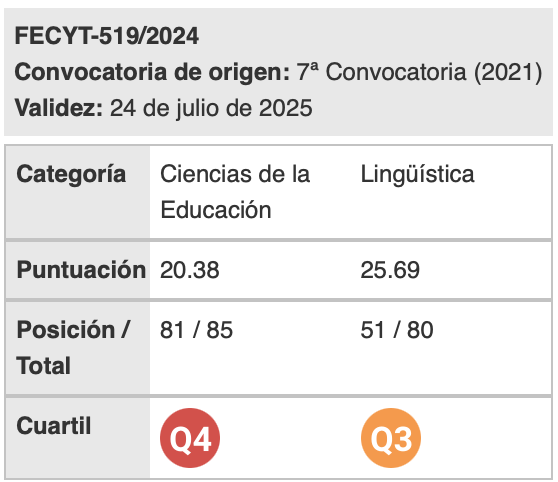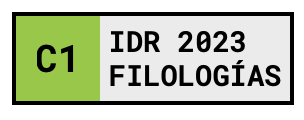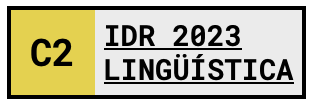¿Cuán gramaticalmente complejos son los títulos de los artículos científicos en las ciencias naturales?
Keywords:
Titles, research papers, natural sciences, English, , grammar, morphosyntax, compound words, lexical densityAbstract
This paper examines a corpus of 150 titles of research articles published between 2010 and 2013 in Anglo-American natural sciences journals (physics, chemistry and biology) in order to determine their lexical density and grammatical and morphosyntactic features. Towards that end, the frequency of present and past participles, prepositions, coordinating and subordinate conjunctions, and the frequency and length of compound words was recorded in each title. The total number of content and function words was also recorded so as to determine title lexical density. ANOVA tests were applied in order to assess whether statistically significant differences in the frequency of the above mentioned variables were detected within and across disciplines and in the whole corpus. Our results showed that, in the three disciplines, the frequency of the past participle is higher than that of the present participle (p = 0,04). They also disclosed that prepositions are the most frequently used function words and that they outnumber coordinating conjunctions (p = 0,02). Compound words were found to be very frequent, especially 2- and 3-word ones. As for title lexical density, it was found to be similar across disciplines (3,1). The only statistically significant cross-disciplinary difference detected was that present participles are more frequently used in chemistry than in biology (p= 0,001). Our findings reflect the complexity of the scientific concepts expressed in natural sciences research article titles. Because titles are frequently the only section of a paper scientists read so as to decide whether to read on or not, we present a few pedagogical tips that could be applied in reading and/or writing ESP courses.
DOI: 10.20420/rlfe.2015.0012
Downloads
References
Afful, J. y Mwinlaaru, I. (2010). Commonality and individuality in academic writing: An analysis of conference paper titles of four scholars. ESP World, 1(27). <http://www.esp-world.info> [25/06/2013]
Akirov, A., y Salager-Meyer, F. (1985). Difficulty analysis and reading comprehension: an experimental study with Venezuelan science students. English for Specific Purposes, 94, 6-12.
Alcaraz-Ariza, M. y Salager-Meyer, F. (2012). Análisis contrastivo de los títulos en los artículos de investigación de neurología redactado en español e inglés. Language for Special Purposes, Professional Communication, Knowledge Management and Cognition, 3(2), 27-50.
Anthony, L. (2001). Characteristic features of research article titles in computer science. IEEE Transactions on Professional Communication, 44(3), 187-194.
Banks, D. (2005). The case of Perrin and Thompson: An example of the use of a mini corpus. English for Specific Purposes, 24(2), 201-213.
Barbic, S., K. Roberts, Z., Durisko, C., Lee; Yachouh, R. y McKenzie, K. (2015). Readability assessment of psychiatry journal. European Science Editing, 41(1), 3-11.
Belcher, D. (2005). Editorial. English for Specific Purposes, 14, 119-121.
Belcher, D. (2009). English for Specific Purposes in theory and practice. Ann Arbor, MI: University of Michigan Press.
Biacchi, A. (2003) Relation complexity of titles and texts: A semiotic taxonomy. En L. Merlini Barbaresi (Ed.), Complexity in language and text (pp. 319-341). Pisa: PLUS.
Biber, D. y Gray, B. (2010). Challenging stereotypes about academic writing: Complexity elaboration, explicitness. Journal of English for Academic Purposes, 9(1), 2-20.
Budgell, B.S. (2013). The language of integrative medicine. Journal of Integrative Medicine. 11(3), 229-232.
Busch-Lauer, I. (2000). Titles of English and German research papers in medicine and linguistics theses and research articles. En A. Trosborg (Eds.), Analysing professional genres (pp. 77-94). Amsterdam/Philadelphia: John Benjamins.
Buxton, A., y Meadows, A. (1977). The variation in the information content of titles of research papers with time and discipline. Journal of Documentation, 33(1), 46-52.
Cheng, S., Chih-Wei, K. y Chih-Hua, K. (2012). Research article titles in applied linguistics. Journal of Academic Language & Learning, 6(1), A1-14.
Day, R. (1998). How to write and publish a scientific paper. Cambridge: Cambridge University Press.
Dillon, J. (1982). In pursuit of the colon: A century of scholarly progress: 1880–1980. The Journal of Higher Education, 53(1), 93-99.
Diodato, V. y Pearson, K. (1985). Source indexing in science journals and indexing services: a survey of current practices. Science and Technology Libraries 6, 103-118.
Entralgo, J., Salager-Meyer, F. y Luzardo Briceño, M. (2015). Títulos de artículos de investigación escritos en inglés: un estudio interdisciplinario, Núcleo. En prensa.
Fortanet, I., Coll J., Palmer J. y Posteguillo S. (1997). The writing of titles in academic research articles. En R. M. Chamorro y A. R. Navarrete (Eds.), Lenguas aplicadas a las ciencias y la tecnología (pp. 155-158). Cáceres, España: Servicio de Publicaciones de la Universidad de Extremadura.
Flowerdew, L. (2005). An integration of corpus-based and genre-based approach to text analysis in EAP/ESP: Countering criticisms against corpus-based methodologies. English for Specific Purposes, 25(3), 321-332.
Gesuato, S. (2009). Encoding of information in titles: Practices across four genres in linguistics‟. En C. Taylor (Eds.), The role of e-corpora in translation and language learning (pp. 127-157). Ecolingua.
Goodman, N. (2000). Survey of active verbs in the titles of clinical trials reports. British Medical Journal, 320, 914-915.
Goodman, R., Thacker, S.B. y Siegel, P. (2001). What’s in a title? A descriptive study of article titles in peer-reviewed medical journals. Science Editor, 24(3), 75-78.
Haggan, M. (2004). Research paper titles in literature, linguistics and science: Dimensions of attraction. Journal of Pragmatics, 36, 293-317.
Haynes, R., McKibbon, K., Walker, C., Ryan, N. Fitzgerald, D., y Ramsden, M. (1990). On the medical narrative from a diachronic perspective online access to MEDLINE in clinical settings. A study of use and usefulness. Annals of Internal Medicine, 112, 78-84.
Hartley, J. (2008). Academic writing and publishing: A practical handbook. Abingdon: Routlege.
Hodges, P. R. (1983). Keyword in title indexes: effectiveness in retrieval in computer searchers. Special Libraries, 74, 56-60.
Hyland, K., and F. Salager-Meyer (2008) Scientific writing. ARIST (Annual Review of Information Science and Technology), 297-339.
Larsen, P.O., y M. von Ins (2010). The rate of growth in scientific publication and the decline in coverage provided by Science Citation Index. Scientometrics, 84(3), 575-603.
Lewinson, G. y Hartley J. (2005) What’s in a title? Number of words and the presence of colons. Scientometrics, 63(2): 341-356.
Moore, A. (2010). Do article titles attributes influence ciations? Exchanges <http://exchanges.wiley.com/blog/category/research/> [20/01/2013].
Nesi, H. (2013). ESP and corpus studies. En B. Paltridge y S. Starfield (Eds.), The handbook of English for specific purposes (pp. 408-424). London: Wiley-Blackwell.
Salager-Meyer, F. (1984). Compound nominal phrases in scientific technical writings: proportion and rationale. En A. Pugh y J. Ulijn (Eds.), Reading in a Foreign Language: Studies in native and foreign languages (pp. 136-146). London: Heinemann.
Salager-Meyer, F. (1992). A text-type and move analysis study of verb tense and modality distribution in medical English abstracts. English for Specific Purposes, 11(2), 93-115.
Salager-Meyer, F. (2004). Reading medical English: A textbook for medical doctors, students and researchers. Mérida, Venezuela: Consejo de publicaciones de la Universidad de los Andes.
Salager-Meyer, F., Alcaraz-Ariza, M. A. y Luzardo Briceño, M. (2013). Medical case reports and titleology: A diachronic perspective (1840-2009). Revista de lenguas para fines específicos, 19, 397-413.
Sapir, E. (1971). Language. London: Rupert Hart-Davis.
Saussure, F. (1974). Curso de lingüística general. Buenos Aires: Losada.
Soler, M. V. (2007). Writing titles in science: An exploratory study. English for Specific Purposes, 26, 90-102.
Soler, M. V. (2011). Comparative and contrastive observations on scientific titles written in English and Spanish. English for Specific Purposes, 30,124-137.
Stix, G. (1994). The spread of write. Trends on scientific communication. Scientific American, 271, 106-111.
Swales, J. (2004). Research genres. Exploration and application. Cambridge: Cambridge University Press.
Wang, Y. y Bai, Y. (2007). A corpus-based syntactic study of medical research article titles. System, 35, 38–399.
West, M.P. (1053). A general word list of English words with semantic frequencies and a supplementary word-list for the writing of popular science and technology. Longman: Longmans Green.
Whissell, C. (1999). Linguistic complexity of abstracts and titles in highly cited journals. Perceptual and Motor Skills, 88, 76-86.
Yitzhaki, M. (1994). Relation of title length of journal articles to number of authors. Scientometrics, 30, 321-332.
Zeiger, M. (2000). Essentials of writing biomedical research papers. NY: McGraw-Hill.
Downloads
Published
How to Cite
Issue
Section
License
Authors who publish with this journal agree to the following terms:
- Authors retain copyright and grant the journal right of first publication with the work simultaneously licensed under a Creative Commons Attribution License that allows others to share the work with an acknowledgement of the work's authorship and initial publication in this journal.
- Authors are able to enter into separate, additional contractual arrangements for the non-exclusive distribution of the journal's published version of the work (e.g., post it to an institutional repository or publish it in a book), with an acknowledgement of its initial publication in this journal.
- Authors are permitted and encouraged to post their work online (e.g., in institutional repositories or on their website) prior to and during the submission process, as it can lead to productive exchanges, as well as earlier and greater citation of published work (See The Effect of Open Access).

Revista de Lenguas para fines específicos is licensed under a Creative Commons Reconocimiento-NoComercial-SinObraDerivada 4.0 Internacional License.
























